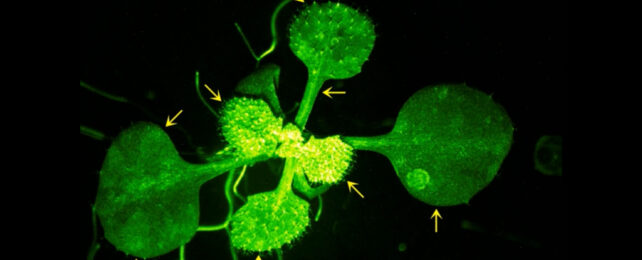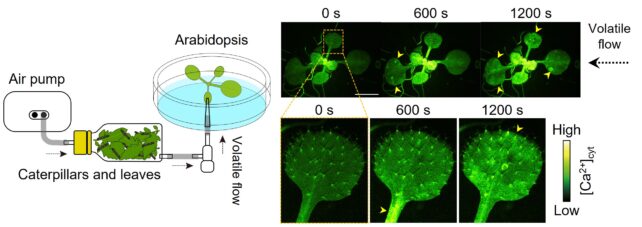ARTICLE AD
 A mustard plant responds to airborne danger cues released by another plant. (Aratani et al., Nature Communications, 2023)
A mustard plant responds to airborne danger cues released by another plant. (Aratani et al., Nature Communications, 2023)
Imperceptible to us, plants are surrounded by a fine mist of airborne compounds that they use to communicate and protect themselves. Kind of like smells, these compounds repel hungry herbivores and warn neighboring plants of incoming assailants.
Scientists have known about these plant defenses since the 1980s, detecting them in over 80 plant species since then. More recently, a team of Japanese researchers deployed real-time imaging techniques to reveal how plants receive and respond to these aerial alarms.
This was a big gap in our understanding of plant chatter: We knew how plants send messages, but not how they receive them.
In the study, published last year, Yuri Aratani and Takuya Uemura, molecular biologists at Saitama University in Japan, and colleagues rigged up a pump to transfer compounds emitted by injured and insect-riddled plants onto their undamaged neighbors, and a fluorescence microscope to watch what happened.
frameborder="0″ allow="accelerometer; autoplay; clipboard-write; encrypted-media; gyroscope; picture-in-picture; web-share" referrerpolicy="strict-origin-when-cross-origin" allowfullscreen>
Caterpillars (Spodoptera litura) were set upon leaves cut from tomato plants and Arabidopsis thaliana, a common weed in the mustard family, and the researchers imaged the responses of a second, intact, insect-free Arabidopsis plant to those danger cues.
These plants weren't any ordinary weeds: They had been genetically altered so their cells contained a biosensor that fluoresced green when an influx of calcium ions was detected. Calcium signaling is something human cells use to communicate too.
The team used a similar technique to measure calcium signals in a study last year of fluorescent Mimosa pudica plants, which quickly move their leaves in response to touch, to avoid predators.
This time, the team visualized how plants responded to being bathed in volatile compounds, which plants release within seconds of wounding.
 The experimental set-up to visualize calcium signaling in Arabidopsis leaves. (Aratani et al. Nature Communications, 2023)
The experimental set-up to visualize calcium signaling in Arabidopsis leaves. (Aratani et al. Nature Communications, 2023)It wasn't a natural set-up; The compounds were concentrated in a plastic bottle and pumped onto the recipient plant at a constant rate, but this allowed the researchers to analyze what compounds were in the pungent mix.
As you can see in the video above, the undamaged plants received the messages of their injured neighbors loud and clear, responding with bursts of calcium signaling that rippled across their outstretched leaves.
Analyzing the airborne compounds, the researchers found that two compounds called Z-3-HAL and E-2-HAL induced calcium signals in Arabidopsis.
They also identified which cells are the first to respond to the danger cues by engineering Arabidopsis plants with fluorescent sensors exclusively in guard, mesophyll, or epidermal cells.
Guard cells are bean-shaped cells on plant surfaces that form stomata, small pores that open up to the atmosphere when plants 'breathe' in CO2. Mesophyll cells are the inner tissue of leaves, and epidermal cells are the outermost layer or skin of plant leaves.
When Arabidopsis plants were exposed to Z-3-HAL, guard cells generated calcium signals within a minute or so, after which mesophyll cells picked up the message.
What's more, pre-treating plants with a phytohormone that shuts stomata significantly reduced calcium signaling, suggesting stomata act as the 'nostrils' of the plant.
"We have finally unveiled the intricate story of when, where, and how plants respond to airborne 'warning messages' from their threatened neighbors," Masatsugu Toyota, a molecular biologist at Saitama University in Japan and senior author of the study, explained when the study was published.
"This ethereal communication network, hidden from our view, plays a pivotal role in safeguarding neighboring plants from imminent threats in a timely manner."
The study has been published in Nature Communications.
An earlier version of this article was published in January 2024.

 8 months ago
55
8 months ago
55 

